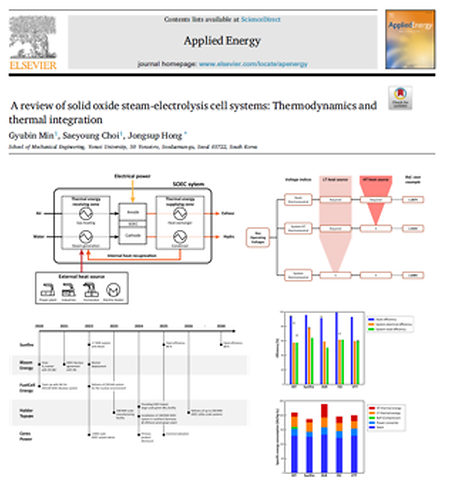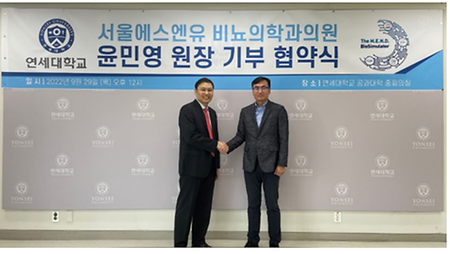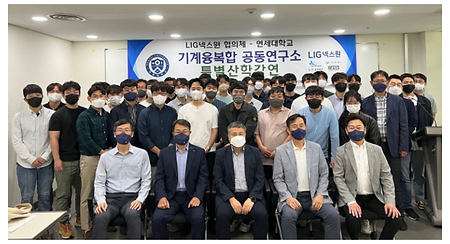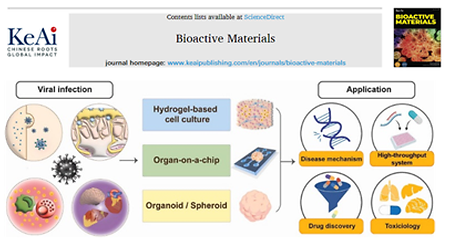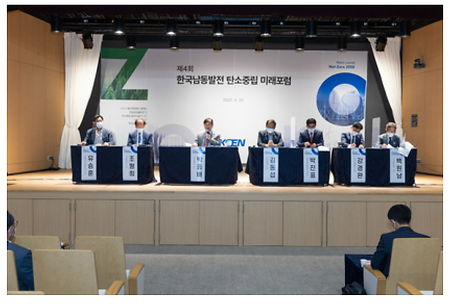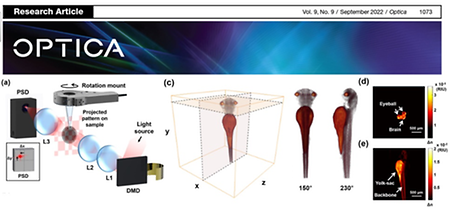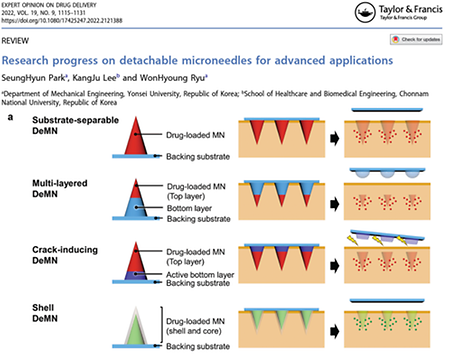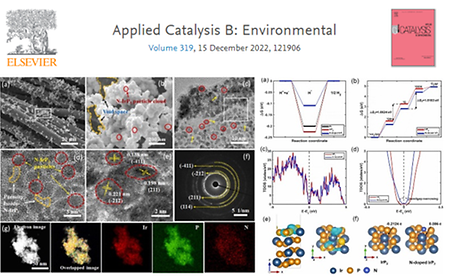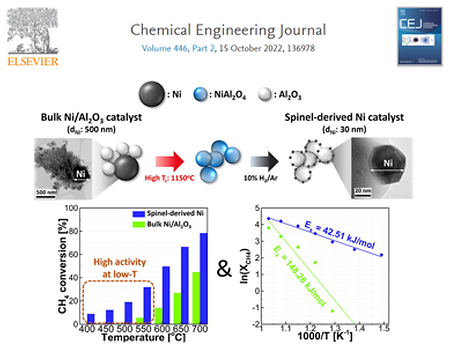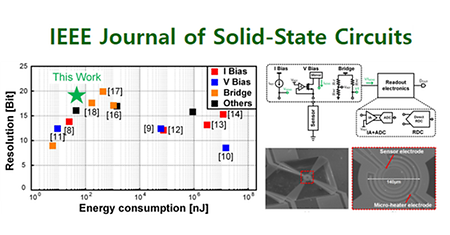-
78
- A review of solid oxide steam-electrolysis cell systems for green hydrogen production: Thermodynamics and thermal integr
- A review of solid oxide steam-electrolysis cell systems for green hydrogen production: Thermodynamics and thermal integration Professor Jongsup Hong's research group (co-first authors: Gyubin Min and Saeyoung Choi) published a review article on thermodynamic mechanisms and thermal integration of solid oxide steam-electrolysis cell (SOEC) systems with system verification status. Although SOEC systems can produce green hydrogen, one of the most important energy carriers for achieving decarbonization, there has been one critical issue in that the system requires a high-temperature heat source depending on the operating conditions. However, the SOEC system research community has only been focused on electrical characteristics: integration with renewable electricity sources. Therefore, Professor Hong's group analyzed the thermodynamic mechanisms of SOEC systems and suggested potential high-temperature heat sources that can be integrated. Furthermore, Professor Hong's group suggested key operating parameters and performance indices in a standardized manner, on which commercialized SOEC systems were analyzed. This review highlights that the thermal aspect of the SOEC system is as much important as the electrical characteristics. Professor Hong's group is continuing research on the thermal integration of SOEC systems. This review paper has been published in Applied Energy (IF: 11.446, JCR upper 6.3%).
- 기계공학부 2022.11.16
-
77
- Endowment agreement ceremony between Multi-scale Fluid Dynamics Lab(MFDL) and Seoul SNU Urology Clinic (2022.09.29)
- Endowment agreement ceremony between Multi-scale Fluid Dynamics Lab(MFDL) and Seoul SNU Urology Clinic Professor Joon Sang Lee's research team at Yonsei University hosted a donation agreement ceremony with Seoul SNU Urology Clinic on September 29 (Thursday) at Yonsei University College of Engineering. The donation will be used for "N-UDS, a non-invasive urodynamic test based on machine learning," developed by The M.E.N.D BioSimulator, the research team's startup company. This technology is a automated platform for bladder and urethral function diagnosis through artificial intelligence. It is expected to be able to broaden the scope of its application to primary medical institutions. Min Young Yoon, director of Seoul SNU Urology Clinic, a hospital dedicated to urology and pain treatment, said, “I moved from the Seoul National University Hospital, a tertiary medical institution, to a primary medical institution, and while diagnosing/treating patients, I felt the importance of cutting-edge diagnostic equipment, so I have collaborated with Professor Lee’s research team. And I decided to donate because I thought that the development of medical diagnostic equipment could be expected by creating a better R&D environment.” The donation will be used to develop diagnostic equipment at the donor's will, and Professor Lee said, "I will use the donated fund to develop equipment so that even primary medical institutions like the SNU urology clinic can utilize the high-quality diagnostic devices."
- 기계공학부 2022.11.16
-
76
- '"LIG Nex1 Public Day" for inducstry-university cooperation and defense R&D capabilities (2022.09.27)
- '"LIG Nex1 Public Day" for inducstry-university cooperation and defense R&D capabilities Professor No-Cheol Park, Woochul Kim, and Jun Young Yoon in the Department of Mechanical Engineering held a 'Public Day' to introduce research achievements in the field of convergence mechanical technology. At this event, industry-university research activities such as ▲Structural safety analysis of large radar structures (Professor No-Chul Park) ▲ Design and analysis of radar heat dissipation and cooling system (Professor Woo-Cheol Kim) ▲ Design of actuator and drive controller for fast steering mirror system (Professor Jun-Young Yoon) has been introduced. the LIG Nex1 and consultative group has been conducting various joint research and high-density cooperative activities.
- 기계공학부 2022.11.16
-
75
- 3D engineered tissue models for studying human-specific infectious viral diseases (2022.09.22)
- 3D engineered tissue models for studying human-specific infectious viral diseases Professor Jongbaeg Kim's research team in the Department of Mechanical Engineering and a research team at the Korea Institute of Science and Technology published a review paper on "Three-dimensional engineered tissue model for the study of human-specific infectious virus disease". This paper was published in the journal of 'Bioactive materials' (Impact Factor: 12.874, top 2%) in September 22th, 2022. In addition to coronavirus, which has recently become a social issue, infectious viruses that can cause diseases in various organs of the human body are classified. In addition, a three-dimensional engineered tissue model that can be used for the pathogenesis and treatment of infectious viral diseases similar to in vivo was reviewed. The link: doi.org/10.1016/j.bioactmat.2022.09.010
- 기계공학부 2022.11.16
-
74
- Guest lecture "Power generation technology for Carbon neutrality" at The 4th Carbon neutrality forum (2022.09.22)
- Guest lecture "Power generation technology for Carbon neutrality" at The 4th Carbon neutrality forum Professor Hyung Hee Cho gave a guest lecture "Power generation technology for Carbon neutrality" at the 4th Carbon Neutrality Forum hosted by KOEN(Korea Energy) as an expert in the field of gas and hydrogen turbines. Lecture on 'power generation technology for carbon neutrality' focused on power generation technology in response to the announcement of the draft of the 10th Basic Plan for Electricity Supply and Demand by The Ministry of Trade, Industry and Energy.
- 기계공학부 2022.11.16
-
73
- Quantitative refractive index tomography of millimeter-scale objects using single-pixel wavefront sampling (2022.09.19)
- Quantitative refractive index tomography of millimeter-scale objects using single-pixel wavefront sampling Professor Chulmin Joo's research team at the Department of Mechanical Engineering introduced an optical diffraction tomography (ODT) method capable of producing 3D refractive index (RI) distribution of transparent samples via a single-pixel detector. Conventional ODT based on optical interferometry can produce high-resolution 3D RI maps, but the interferometry-based ODT is unsuitable for imaging large samples exceeding several tens of micrometers and is greatly influenced by speckle noise. This study presents a noise-robust 3D phase tomography technique suitable for imaging millimeter-scale objects. This research was published in the journal 'Optica' (top 6.93% in Optics, Impact Factor: 10.644) on September 19, 2022. The link: opg.optica.org/optica/fulltext.cfm?uri=optica-9-9-1073&id=503284
- 기계공학부 2022.11.16
-
72
- Research progress on detachable microneedles for advanced applications (2022.09.07)
- Research progress on detachable microneedles for advanced applications Professor Won-Hyung Ryu's research team from the Department of Mechanical Engineering wrote a review paper of the research trend and direction of the detachable microneedle by suggesting a new classification method according to the shape of the detachable microneedle. This review paper was published in 'Expert Opinion on Drug Delivery' (Vol. 19, Issue 9, 2022). The link: doi.org/10.1080/17425247.2022.2121388
- 기계공학부 2022.11.16
-
71
- Development of high-activity water electrolysis catalyst for high-efficiency alkaline fuel cell (2022.09.02)
- Development of high-activity water electrolysis catalyst for high-efficiency alkaline fuel cell Professor Seong Chan Jun's research team in the Department of Mechanical Engineering has developed a robust catalyst with high activity and high efficiency for efficient water electrolysis. A very active electrocatalyst similar to Pt/RuO2 is required for application to commercial high-efficiency alkaline fuel cells, but there is still a limitation in that it is difficult to synthesize. This research team overcame this limitation by using N-doped noble metal iridium diphosphide (N-IrP2 @CC) to achieve higher water decomposition current density than conventional catalysts. The results of this study were confirmed for publication this December in 'Applied Catalysis B: Environmental' (Impact Factor: 24.319, within the top 2%, Volume 319), an international excellent journal. The link: https://doi.org/10.1016/j.apcatb.2022.121906
- 기계공학부 2022.11.16
-
70
- A step towards carbon neutrality, achieved with nano-nickel particles (2022.08.30)
- A step towards carbon neutrality, achieved with nano-nickel particles Professor Jongsup Hong's research group in the Department of Mechanical Engineering has secured a high-stability nano-catalyst manufacturing technology with high conversion of CO2 and CH4 even at low temperatures. In order to promote the decomposition reaction of CO2, which generally has a high activation energy barrier and requires a high energy input, Professor Jongsup Hong's research group formed an optimal catalyst using a new anchoring technique with inexpensive nickel and alumina and evaluated its performance. The result of this study has significance in that it can contribute to the production of clean H2 and synthesis gas by actively utilizing the greenhouse gases (CO2 and CH4). The result was published in 'Chemical Engineering Journal' (Impact Factor: 16.744, Top 2.62%, Volume 446) in October 2022. The link: https://doi.org/10.1016/j.cej.2022.136978
- 기계공학부 2022.11.10
-
69
- Development of MEMS-based gas sensing system with ultra-high resolution, low power consumption, and gas selectivity
- Development of MEMS-based gas sensing system with ultra-high resolution, low power consumption, and gas selectivity Professor Jongbaeg Kim's research team in the Department of Mechanical Engineering and a research team in the Department of Electrical and Electronic Engineering conducted a study on a "MEMS-based gas sensing system." This study was published in the journal of 'IEEE Journal of Solid-state Circuits' (Impact Factor: 6.12) in August 2022. In this paper, we present an ultra-low power gas sensing system with an ultra-high resolution by integrating MEMS-based resistive gas sensors and Resistors-to-Digital Converter. Furthermore, the selectivity of the gas sensor was obtained by using different reactivity differences when driven at different temperatures. The link: 10.1109/JSSC.2022.3197549
- 기계공학부 2022.11.10


